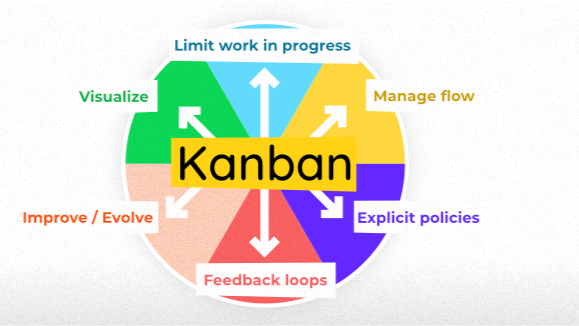In today’s fast-paced and competitive business environment, organizations strive to optimize their processes, reduce waste, and improve efficiency. Kanban, a Japanese term meaning "visual signal" or "card," has emerged as a proven methodology to achieve these goals. Originating in the Toyota Production System (TPS), Kanban systems are now widely used across industries, including manufacturing, software development, healthcare, and logistics.?
This article delves into the principles, benefits, and implementation strategies of Kanban systems to enhance workflow and reduce inventory waste.
Understanding Kanban Systems
At its core, Kanban is a visual workflow management tool that helps organizations visualize tasks, limit work in progress (WIP), and improve efficiency. It relies on the use of Kanban boards, cards, and lanes to represent and track work items through various stages of a process.
Key Principles of Kanban
- Visualize Workflow: Kanban boards visually represent the workflow, typically divided into columns such as "To Do," "In Progress," and "Done." This visualization provides clarity and helps teams identify bottlenecks and inefficiencies.
- Limit Work in Progress (WIP): By setting limits on the number of tasks in progress at any given time, teams can focus on completing existing tasks rather than starting new ones. This reduces multitasking and ensures steady progress.
- Manage Flow: Kanban encourages teams to monitor and manage the flow of work, aiming for a smooth and predictable process. Metrics like cycle time and lead time help track efficiency.
- Make Process Policies Explicit: Clearly defined rules and processes ensure consistency and alignment within the team. This helps in maintaining quality and understanding expectations.
- Implement Feedback Loops: Regular reviews and retrospectives allow teams to assess performance and identify areas for improvement.
- Collaborate for Continuous Improvement: Kanban fosters a culture of continuous learning and adaptation, encouraging teams to refine processes and eliminate waste over time.
Click Here to Join the Over 7000 Students Taking Highly Rated Courses in Manufacturing, Quality Assurance/Quality Control, Project Management, Engineering, Food Safety, Lean Six Sigma, Industrial Safety (HSE), Lean Manufacturing, Six Sigma, ISO 9001, ISO 14001, ISO 22000, ISO 45001, FSSC 22000, Product Development etc. on UDEMY.
Reducing Inventory Waste with Kanban
Inventory waste is a significant challenge in many industries, particularly manufacturing. Kanban addresses this issue by aligning production with demand, ensuring materials and products are available "just in time" (JIT).
How Kanban Reduces Inventory Waste
- Demand-Driven Production: Kanban uses pull systems, where production is based on actual demand rather than forecasts. This minimizes overproduction and excess inventory.
- Optimized Resource Allocation: By visualizing workflow and limiting WIP, Kanban prevents resources from being tied up in unneeded inventory, freeing them for other critical tasks.
- Improved Communication: Kanban cards serve as signals that trigger replenishment only when stock reaches a predefined level, reducing the risk of stockouts or overstocking.
- Enhanced Flexibility: Kanban’s adaptive approach allows organizations to quickly respond to changes in customer demand, minimizing waste from obsolescence or excess production.
Benefits of Kanban Systems
Implementing a Kanban system offers numerous advantages for organizations aiming to improve their operations:
- Increased Transparency: Visualizing workflows makes it easier to identify inefficiencies, track progress, and improve accountability.
- Improved Efficiency: By focusing on completing tasks rather than starting multiple new ones, teams achieve faster turnaround times and better quality.
- Cost Reduction: Reduced inventory levels, minimized waste, and optimized resource utilization lead to significant cost savings.
- Scalability: Kanban systems can be scaled to suit the needs of any organization, from small teams to large enterprises.
- Better Collaboration: Clear communication and shared understanding of workflows enhance teamwork and coordination.
Click Here to Join the Over 7000 Students Taking Highly Rated Courses in Manufacturing, Quality Assurance/Quality Control, Project Management, Engineering, Food Safety, Lean Six Sigma, Industrial Safety (HSE), Lean Manufacturing, Six Sigma, ISO 9001, ISO 14001, ISO 22000, ISO 45001, FSSC 22000, Product Development etc. on UDEMY.
Implementing Kanban Systems
Successful implementation of Kanban requires a strategic approach and commitment to continuous improvement. Here are key steps:
- Start Small: Introduce Kanban on a small scale, such as a single team or process, to test and refine the system.
- Define Workflows: Map out the current workflow, including all stages and transitions, to create a baseline for improvement.
- Set WIP Limits: Establish limits for each stage of the workflow to prevent overloading and ensure smooth progress.
- Use Visual Management Tools: Invest in physical or digital Kanban boards to visualize tasks and track progress.
- Monitor and Measure Performance: Use metrics like lead time, cycle time, and throughput to evaluate efficiency and identify areas for improvement.
- Encourage a Continuous Improvement Mindset: Foster a culture of experimentation and learning to drive ongoing enhancements.
Applications of Kanban Across Industries
- Manufacturing: Kanban optimizes production schedules, reduces inventory levels, and ensures timely delivery of components.
- Software Development: Agile teams use Kanban to manage workflows, prioritize tasks, and improve delivery speed.
- Healthcare: Hospitals use Kanban to manage patient flow, track inventory, and streamline administrative tasks.
- Logistics: Kanban enhances supply chain visibility, reduces lead times, and improves order fulfillment.
Conclusion
Kanban systems are a powerful tool for enhancing workflow and reducing inventory waste. By visualizing processes, limiting work in progress, and focusing on continuous improvement, organizations can achieve greater efficiency, reduce costs, and deliver better value to their customers. Whether in manufacturing, software development, or other sectors, adopting Kanban principles can lead to significant operational gains and sustainable growth.
Collection of In-Demand?Industry Courses:
1. ? ?MANUFACTURING, QUALITY, PRODUCT DEVELOPMENT, OPERATIONS & SUPPLY CHAIN MANAGEMENT
2. ? ? ISO MANAGEMENT SYSTEMS IMPLEMENTATION & INTERNAL AUDITOR COURSES
3. ? ? ?ISO LEAD AUDITOR COURSES ?

Spare Parts Sales Executive. Toyota Production System. Toyota History. Toyota Way.
1 个月????.
Optimizing SME's with AI. Reduce operational costs!
1 个月Adebayo Bamidele Olanrewaju CSSMBB?, MNSChE, MNSE, COREN, your insights on kanban's impact across industries are truly eye-opening. ??